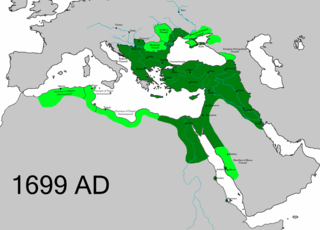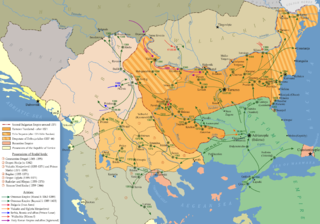Related Research Articles

The Ottoman Empire, historically and colloquially the Turkish Empire, was an empire that controlled much of Southeast Europe, Western Asia, and Northern Africa between the 14th and early 20th centuries. It was founded at the end of the 13th century in northwestern Anatolia in the town of Söğüt by the Turkoman tribal leader Osman I. After 1354, the Ottomans crossed into Europe and, with the conquest of the Balkans, the Ottoman beylik was transformed into a transcontinental empire. The Ottomans ended the Byzantine Empire with the conquest of Constantinople in 1453 by Mehmed the Conqueror.

Selim III was the sultan of the Ottoman Empire from 1789 to 1807. Regarded as an enlightened ruler, the Janissaries eventually deposed and imprisoned him, and placed his cousin Mustafa on the throne as Mustafa IV. Selim was subsequently killed by a group of assassins.

The Tanzimat was a period of reform in the Ottoman Empire that began with the Gülhane Hatt-ı Şerif in 1839 and ended with the First Constitutional Era in 1876. The Tanzimat era began with the purpose, not of radical transformation, but of modernization, desiring to consolidate the social and political foundations of the Ottoman Empire. It was characterised by various attempts to modernise the Ottoman Empire and to secure its territorial integrity against internal nationalist movements and external aggressive powers. The reforms encouraged Ottomanism among the diverse ethnic groups of the Empire and attempted to stem the tide of the rise of nationalism in the Ottoman Empire.

The military of the Ottoman Empire was the armed forces of the Ottoman Empire.

In the late eighteenth century, the Ottoman Empire faced numerous enemies. In response to these threats, the empire initiated a period of internal reform. The period of these reforms is known as the Tanzimat, and led to the end of the Old Regime period. The Ottoman central state was significantly strengthened, despite the empire's precarious international position. Over the course of the nineteenth century, the Ottoman state became increasingly powerful and rationalized, exercising a greater degree of influence over its population than in any previous era. The process of reforming and modernization in the empire began with the declaration of the Nizam-I Cedid during the reign of Sultan Selim III and was punctuated by several reform decrees, such as the Hatt-ı Şerif of Gülhane in 1839 and the Hatt-ı Hümayun in 1856.

Mehmed Fuad Pasha, sometimes known as Keçecizade Mehmed Fuad Pasha and commonly known as Fuad Pasha, was an Ottoman administrator and statesman, who is known for his prominent role in the Tanzimat reforms of the mid-19th-century Ottoman Empire, as well as his leadership during the 1860 Mount Lebanon civil war in Syria. He represented a modern Ottoman era, given his openness to European-style modernization as well as the reforms he helped to enact.
The Ottoman Armenian population varied throughout history. The number of Armenians within the empire between 1914 and 1915 is a controversial topic. Most estimates by Western scholars range from 1.5 to 2.4 million. According to Britannica prior to 1915 and Samuel Cox, American Embassy in Istanbul from 1880-1886, it was 1.75 million and 2.4 million, respectively.

Alemdar Mustafa Pasha was an Ottoman military commander and a Grand Vizier born in Hotin in the then Ottoman territory of Ukraine in 1765. Of Albanian origin, he hailed from the village of Goskovë near Korçë).

The Nizam-i Cedid was a series of reforms carried out by Ottoman Sultan Selim III during the late 18th and the early 19th centuries in a drive to catch up militarily and politically with the Western powers. The New Order regime was launched by Selim III and a coalition of reformers. Its central objectives were the creation of a professional army along European lines, a private treasury to finance military spending, and other administrative reforms. The age of the New Order can be generally said to have lasted from 1789 to 1807, when Selim III was deposed by a Janissary coup.

The history of the Ottoman Empire in the 18th century has classically been described as one of stagnation and reform. In analogy with 18th-century France, it is also known as the Ancien Régime or Old Regime, contrasting with the "New Regime" of the Nizam-i Cedid and Tanzimat in the 19th century.

The history of Ottoman Bulgaria spans nearly 500 years, from the conquest of the smaller kingdoms emerging from the disintegrating Second Bulgarian Empire by the Ottoman Empire in the late 14th century, to the Liberation of Bulgaria in 1878. The brutal suppression of the Bulgarian April Uprising of 1876 and the public outcry it caused across Europe led to the Constantinople Conference, where the Great Powers tabled a joint proposal for the creation of two autonomous Bulgarian vilayets, largely corresponding to the ethnic boundaries drawn a decade earlier with the establishment of the Bulgarian Exarchate.

The Vilayet of the Danube or Danubian Vilayet was a first-level administrative division (vilayet) of the Ottoman Empire from 1864 to 1878. In the late 19th century it reportedly had an area of 34,120 square miles (88,400 km2).

The Vilayet of Adrianople or Vilayet of Edirne was a first-level administrative division (vilayet) of the Ottoman Empire.

Ottoman casualties of World War I were the civilian and military casualties sustained by the Ottoman Empire during the First World War. Almost 1.5% of the Ottoman population, or approximately 300,000 people of the Empire's 21 million population in 1914, were estimated to have been killed during the war. Of the total 300,000 casualties, 250,000 are estimated to have been military fatalities, with civilian casualties numbering over 50,000. In addition to the 50,000 civilian deaths, an estimated 1.5 million Armenians, 750,000 Greeks, and 300,000 Assyrians were systematically targeted and killed by Turkish authorities either via the military or Kurdish gangs. Likewise, starting in 1916, Ottoman authorities forcibly displaced an estimated 700,000 Kurdish people westward, and an estimated 350,000 died from hunger, exposure, and disease.
This article is about the demographics of the Ottoman Empire, including population density, ethnicity, education level, religious affiliations and other aspects of the population.
Ihtisab, or ihtisap was a type of tax on markets in the Ottoman Empire; the muhtasib or ihtisap ağasi - the ihtisab collector - had a broader role in regulating and taxing markets under the authority of the kadı.

Cedid Atlas was the first modern atlas in the Muslim world, printed and published in 1803 in Constantinople. The atlas was created by translating and adapting maps from William Faden's General Atlas and the full title of the atlas reads as Cedid Atlas Tercümesi and in most libraries outside Turkey, it is recorded and referenced accordingly.

The Nizam-ı Cedid Army refers to the new military establishment of the Nizam-ı Cedid reform program. The Nizam-i Cedid army was largely a failure in its own time, but proved to be a much more effective infantry force than the Janissaries.

The 1914 Ottoman census was collected and published as the Memalik-i Osmaniyyenin 1330 Senesi Nütus Istatistiki. These statistics were prepared by using the figures from the 1905–06 census of the Ottoman Empire and reflecting births and deaths registered in six years from last. The register states that birth and mortality rate used on "nomads" such as the nomadic Nestorians.

Süleyman Bey or Capanoğlu Süleyman Bey was an Ottoman military leader and office holder from the Çapanoğlu family, one of the most powerful Ottoman dynasties of the 18th century. Under his guidance the family reached its peak of prominence.
References
- ↑ Shaw 1978 , p. 325
- ↑ Stanford J. Shaw. "The Ottoman Census System and Population, 1831-1914". International Journal of Middle East Studies. 9 (3): 326.
- ↑ Shaw 1978 , p. 325
- ↑ Shaw 1978 , p. 327
- ↑ Shaw 1978 , p. 327
- ↑ Shaw 1978 , p. 327
- ↑ Shaw 1978 , p. 327
- ↑ Shaw 1978 , p. 330
- ↑ Shaw 1978 , p. 330
- ↑ Shaw 1978 , p. 331